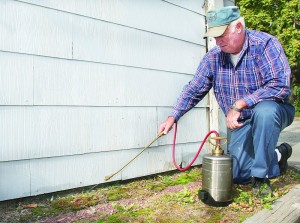How to make it so your home is pest free

Just when you thought your home was your fortress, the numbers and varieties of invasive household pests are growing, say local pest control experts.
There are some simple steps everyone can take to reduce the likelihood of major infestations.
Take bedbugs, for instance. The epidemic that has hit major cities is now out here on the North Fork, according to Craig Rosenberg of North Shore Exterminating.
“One of the biggest areas now is being proactive with bedbugs,” he said. “We’ve had huge bedbug scenarios for the last four or five seasons.”
Mr. Rosenberg recommends bedbug-proof mattress covers that hotels and bed and breakfasts might be well advised to use to deter the creatures.
“And if you’re an individual homeowner with a lot of visitors, you might want to look into mattress covers,” he said. “There is also a new product on the market that resembles a cup with a moat around the edge which slips under the leg of the bed and traps the bugs coming up from the floor or dropping from the bed.”
Walter Ogar of East End Pest Control has been ridding our area of pests for the last 37 years and agrees the bedbug problem is serious.
“I have done quite a few bedbug jobs out here,” he explained. “It’s a big job. You have to take down curtains, pictures and of course there’s the mattress.”
But if your proactive measures don’t work and you wake up itching and covered in nasty welts, Mr. Ogar uses a couple of methods to eliminate the bugs.
“I freeze them or I use a chemical treatment,” he said.
Bedbugs may be the pest du jour but there are other nuisance insects out there.
Some homeowners know only too well how termites and carpenter ants can seriously damage the fabric of a home. Treating those insect infestations traditionally required measures that were not very environmentally friendly.
“Years ago we used chlorodyne-based products that lasted a very long time in the soil. Now we use a chemical treatment that is much kinder to the environment,” said Mr. Ogar.
What about furry pests?
“Fall is the time to review your pest proofing,” Mr. Rosenberg advises. “Raccoons are looking for a nice warm place to hibernate and in spring they’ll give birth in that same spot.” He suggests chimney caps, roof and gable vent screens as well as attic fan screens are helpful in reducing the possibility of finding the attic has become a raccoon flophouse.
Those clever animals may also look elsewhere for an entrance.
“Check under the deck as well and make sure any screening you put down goes a good way into the ground,” he said.
Mr. Rosenberg adds that you should also take a look at areas you might not think of, like your laundry exhaust vent. “Anywhere there’s an opening,” he said.
Mr. Ogar recommends examining cracks in the foundation to mouse-proof your home.
“It’s never 100 percent,” he said. “With a bad infestation, you need traps and bait. Snap traps are effective.”
Mr. Rosenberg agrees that exclusion work for mice is difficult.
“You can slow it down,” he said. “We like to do aggressive trapping first so that we can locate the bodies and then we bait.”
But if in spite of all your efforts you experience the unpleasantness of creatures taking up residence in the attic, it’s time to call in a nuisance wildlife removal expert.
Joel (who requested anonymity as he says animal activists tend not to like some of his work) is a licensed wildlife removal expert who covers the North Fork.
“We are not allowed to release any animals into the wild although we do try and save any songbirds we capture,” he said. According to Joel, the most common nuisance creatures are raccoons and squirrels.
“Each raccoon needs five acres to sustain itself,” he said. “Raccoons keep their young with them for 11 months so you can see why they’re invading peoples’ homes. There’s just not enough habitat for them. The female raccoon comes out at night to feed so we catch them that way.”
Although female raccoons can be extremely aggressive, Joel reserves the most caution for bats.
“Stay away from them,” he advised. “They can be very dangerous. If they’re flying around outside, don’t worry. But if one lone bat gets into the house it’s usually a sick bat. Isolate the bat by closing all the doors around the area and call some qualified person to remove it and take it to the health department.”






